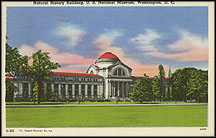noun \ˈpōs(t)-ˌkärd\: a card on which a message may be sent by mail without an envelope and that often has a picture on one side
The United States Postal Service first began issuing pre-stamped postal cards in 1873. They were introduced to the public as an easy way to send quick notes. Until May 19, 1898 the USPS was the only establishment allowed to print postcards. The monopoly ended when Congress passed the Private Mailing Card Act which allowed private publishers and printers to produce and mail their own postcards.
Private Mailing Cards Period, 1898 – 1901:
During the Private Mailing Card period, messages were not allowed on the back of the card. The only area where notes from the sender were permitted was a small space on the front of the card. The postcards required a 1 cent stamp.
Post Card Period, 1901-1907:
In December of 1901, the USPS issued Post Office Order Number 1447 which allowed the words “Post Card” to be on the card instead of the longer “Postal Mailing Card.” Messages were still not allowed on the back of the post cards during this period.
Divided Back Period, 1907-1914:
A major change took place on March 1, 1907 with the way the backs of postcards looked. The left side of the back of the card was now allowed to have message written in that space. The right side of the card was for the address.
White Border Period, 1915-1930:
Up until this period German printers dominated the market in postcard printing. With the start of World War I, postcards were supplied mostly by printers in the United States. During this period, printers saved ink by not printing to the edge of the card leaving the white border around the image.
Linen Period, 1930-1944:
As time went on, new printing processes were developed. During this period, postcards could be printed with high rag content, which gave them a look of being printed on linen or cloth. Bright colors were also introduced during this period.
Modern Photochrome-style Period, 1939 – to date:
This style of postcards first appeared in 1939. The Union Oil Company carried them in their western service stations. Production of the postcards slowed during World War II because of supply shortages, but after the war, this type of postcards dominated the market. The photochrome postcards are in color and are the closest to real photographs and are the ones most familiar to us today.
At RSVP we love the postcard (obviously!). It’s not just a nostalgic piece of every family vacation we ever took – it’s a modern, upscale advertising tool that has proven itself to be as diverse as the pictures on the front. Long live the postcard!
Contributed by Marcella Gillespie.
A quick thank you to our sources for this awesome information:
http://siarchives.si.edu/history/exhibits/postcard/postcard-history
http://en.wikipedia.org/wiki/Postcard















